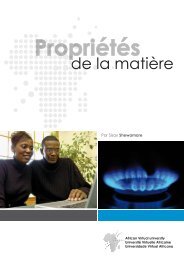Physical Chemistry 2.pdf - OER@AVU - African Virtual University
Physical Chemistry 2.pdf - OER@AVU - African Virtual University
Physical Chemistry 2.pdf - OER@AVU - African Virtual University
Create successful ePaper yourself
Turn your PDF publications into a flip-book with our unique Google optimized e-Paper software.
Effect of temperature on solubility of gases<br />
<strong>African</strong> <strong>Virtual</strong> <strong>University</strong><br />
The solubility of most gases decrease with increasing temperature. For example<br />
oxygen and nitrogen, two major components of air are known to decrease as the<br />
temperature increases. It is for this reason that many types of fish can only survive in<br />
cold water as opposed to warm where there are lower amounts of dissolved oxygen.<br />
Comparative data is given in Table 4 showing solubility of selected gases at different<br />
temperatures. Solubility is in grams per 100 g of water when gaseous space over<br />
liquid is saturated with gas and the total pressure is 1 atm.<br />
Table 4 Comparative data depicting the solubility of the gases N 2 , O 2 and CO 2 .<br />
Gas Temperature (°C)<br />
0 20 50 100<br />
N 2 0.0029 0.0019 0.0012 0<br />
O 2 0.0069 0.0043 0.0027 0<br />
CO 2 0.335 0.169 0.076 0<br />
The opposite phenomenon is often observed for solubility of gases in organic solvents.<br />
In this case, solubility increases with increase in temperature. For example, the solubility<br />
of hydrogen, nitrogen, carbon monoxide, helium and neon rise with increasing<br />
temperature in organic solvents such as carbon tetrachloride, toluene and acetone.<br />
Gases become more soluble at higher pressure<br />
A common phenomenon when one opens a can of many beverages is the fizzing<br />
sound as the gas escapes. Although the gases in air are not very soluble at room<br />
temperature, they become increasingly soluble at high pressures. The solubility of a<br />
gas is affected a lot more by pressure than temperature. To understand the effect of<br />
pressure, consider the following equilibrium for dissolution of a gas.<br />
Gas + solvent D solution<br />
An increase in pressure on the system reduces the volume available to the gas. According<br />
Le Châtelier’s principle the system must change to counter act the stress<br />
created. Consequently, the system reacts so as to reduce the pressure by decreasing<br />
the amount of gas. Gas molecules are absorbed from the gaseous phase into solution.<br />
The equilibrium in the above reaction equation is thus shifted to the right i.e.<br />
increased solubility.<br />
If the pressure on the solution is reduced then the reverse effect in equilibrium is<br />
observed, some of the gas molecules leave the solution into the gaseous phase.<br />
Equilibrium shifts to the left of the reaction equation. Fizzing of the cola drink or<br />
any other carbonated drink is a response to the lowering of pressure as the can (or
















